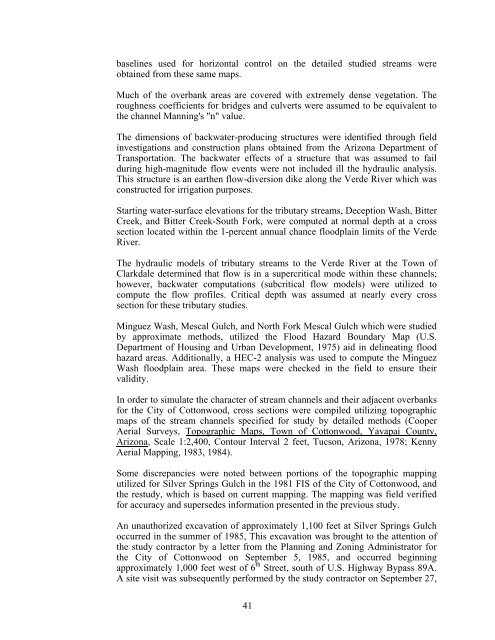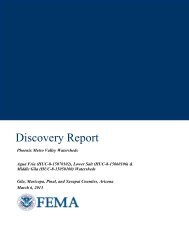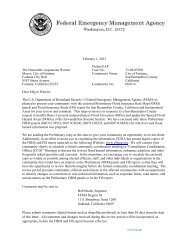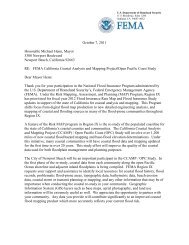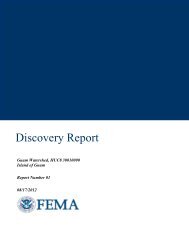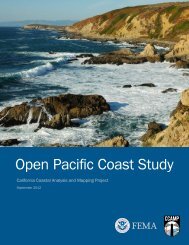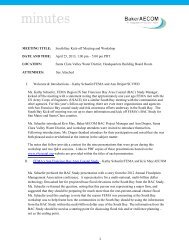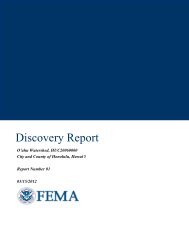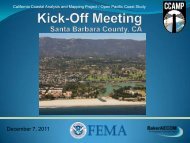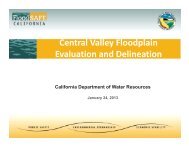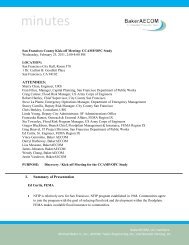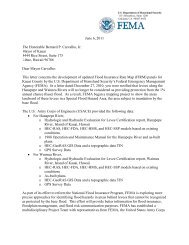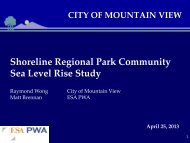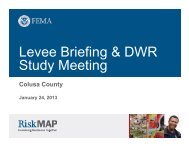YAVAPAI COUNTY, ARIZONA Federal Emergency ... - FEMA Region 9
YAVAPAI COUNTY, ARIZONA Federal Emergency ... - FEMA Region 9
YAVAPAI COUNTY, ARIZONA Federal Emergency ... - FEMA Region 9
Create successful ePaper yourself
Turn your PDF publications into a flip-book with our unique Google optimized e-Paper software.
aselines used for horizontal control on the detailed studied streams were<br />
obtained from these same maps.<br />
Much of the overbank areas are covered with extremely dense vegetation. The<br />
roughness coefficients for bridges and culverts were assumed to be equivalent to<br />
the channel Manning's "n" value.<br />
The dimensions of backwater-producing structures were identified through field<br />
investigations and construction plans obtained from the Arizona Department of<br />
Transportation. The backwater effects of a structure that was assumed to fail<br />
during high-magnitude flow events were not included ill the hydraulic analysis.<br />
This structure is an earthen flow-diversion dike along the Verde River which was<br />
constructed for irrigation purposes.<br />
Starting water-surface elevations for the tributary streams, Deception Wash, Bitter<br />
Creek, and Bitter Creek-South Fork, were computed at normal depth at a cross<br />
section located within the 1-percent annual chance floodplain limits of the Verde<br />
River.<br />
The hydraulic models of tributary streams to the Verde River at the Town of<br />
Clarkdale determined that flow is in a supercritical mode within these channels;<br />
however, backwater computations (subcritical flow models) were utilized to<br />
compute the flow profiles. Critical depth was assumed at nearly every cross<br />
section for these tributary studies.<br />
Minguez Wash, Mescal Gulch, and North Fork Mescal Gulch which were studied<br />
by approximate methods, utilized the Flood Hazard Boundary Map (U.S.<br />
Department of Housing and Urban Development, 1975) aid in delineating flood<br />
hazard areas. Additionally, a HEC-2 analysis was used to compute the Minguez<br />
Wash floodplain area. These maps were checked in the field to ensure their<br />
validity.<br />
In order to simulate the character of stream channels and their adjacent overbanks<br />
for the City of Cottonwood, cross sections were compiled utilizing topographic<br />
maps of the stream channels specified for study by detailed methods (Cooper<br />
Aerial Surveys, Topographic Maps, Town of Cottonwood, Yavapai County,<br />
Arizona, Scale 1:2,400, Contour Interval 2 feet, Tucson, Arizona, 1978; Kenny<br />
Aerial Mapping, 1983, 1984).<br />
Some discrepancies were noted between portions of the topographic mapping<br />
utilized for Silver Springs Gulch in the 1981 FIS of the City of Cottonwood, and<br />
the restudy, which is based on current mapping. The mapping was field verified<br />
for accuracy and supersedes information presented in the previous study.<br />
An unauthorized excavation of approximately 1,100 feet at Silver Springs Gulch<br />
occurred in the summer of 1985, This excavation was brought to the attention of<br />
the study contractor by a letter from the Planning and Zoning Administrator for<br />
the City of Cottonwood on September 5, 1985, and occurred beginning<br />
approximately 1,000 feet west of 6 th Street, south of U.S. Highway Bypass 89A.<br />
A site visit was subsequently performed by the study contractor on September 27,<br />
41


